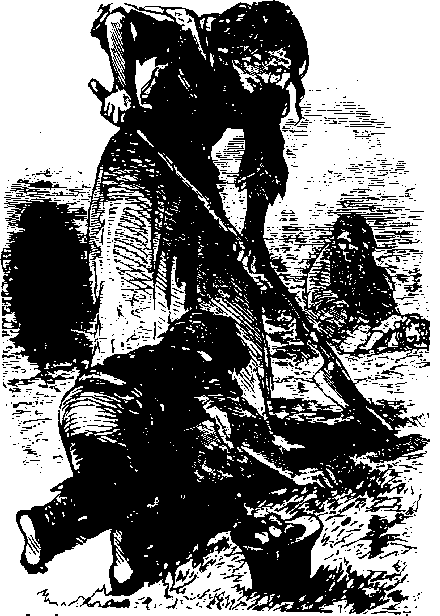THE DORGANS AND THE FAMINE
Fall 1845 - Spring 1851
"An Gorta Mor"
"The Great Hunger"
"The Great Famine"
"The Great Starvation"

'The Great Hunger' which began in Ireland around the Fall of 1845, continued up to 1851, and ended in the deaths of an estimated one million Irish (or one out of every nine inhabitants). To understand the Great Famine, one must realize the expanding population of early 1800's Ireland and the growing dependency on a single crop - the Potato. To realize why it lasted for five years one must understand the politics, culture and economics of the time, since full crop failures did not occur every year between 1845 and 1850.
In 1800, some four and one-half million people lived in Ireland. By the autumn of 1845, when the Great Famine struck Ireland, there were more than eight million. This was the largest increase in the population of Ireland in its history, an increase estimated at 172%. By the time of the Famine Ireland's population of poor was very high, and its population of landlords was very low (est. 5000).
The "white" potato, known today as the Irish potato, originated in the Andean Mountains. In 1532 the Spanish arrived in north Peru and it is speculated that they brought the potato to Europe in the second half of the 16th century. By 1800, the potato had taken root and ninety percent of the Irish population was dependent on the potato as their primary means of caloric intake and as an export.
In September of 1845, a fungus called Phytophthora infestans was infecting Ireland's potato crops, devastating the potato population. About half the Irish potato crop failed in 1845. This event is what began The Great Famine in Ireland.
The next year, 1846, the crop was destroyed again. By 1847 (Black '47) the impact of the famine spelled doom for Ireland. A large proportion of the population died from disease or starvation, while a great number of the people fled the country, largely occuring in a five year period between 1846 to 1851. This event is well noted as one of the greatest catastrophes of the 19th century.
While the blight provided the catalyst for the famine, the calamity was essentially man-made, a poison of blind politics, scientific ignorance, rural suppression, and enforced poverty.
Many Irish landlords sent badly needed grain to England for profit, instead of retaining it for the poorer classes (cottiers and labourers). Without crops or employment the tenants could no longer pay rent, so many lost the lands they may have rented while their landlords exported grain and cattle to offset their losses. The effect of this was multiplied by the fact that the English parliament was reluctant to send any food to Ireland. One official declared in 1846, "It is not the intention at all to import food for the use of the people of Ireland."
Although the net export of food out of Ireland actually decreased over the Famine period, shipping records indicate that 9,992 Irish calves were exported to England during Black '47, a 33 percent increase from the previous year. Irish grain was exported, while cheap Indian meal was (sometimes) imported to feed the poor population. What was not known at the time, however, was the Indian meal contained little or no nutrients and only contributed further to the spread of disease. A majority of Famine victims died from malnutrition-related diseases such as dropsy, dysentery, typhus, scurvy and cholera, rather than directly from starvation.
For many the only alternative to disease and starvation, and the only option to eviction from their tenant lands, was emigration. The Passenger Act of 1847 was passed and it granted each [eligible] emigrant 10 cubic feet and a supply of food and water. Realistically captains didn't obey this act and many people starved or died of disease in cramped quarters aboard the emigrant ships. An estimated one and one-half million Irish emigrated from 1845 to 1851, upwards of 20-45% dying in the "coffin ships" on their journey or shortly after their arrival in their new home.
The overall impacts of the Famine included:
* the decline of the Irish language and customs (in 1835, the number of native Irish speakers was estimated at four million -- in 1851, only 2 million spoke Irish as their first language). During this period the name Dargan became pronounced as Dorgan!
* the devastation of the landless laborer class and small tenant farmer. Maurice Cusack went bankrupt and sold his land to Patrick Dorgan.
* a treeless landscape in many parts of Ireland.
* the shells of homes and "mud" cabins that were rendered uninhabitable.
* a massive decrease in farms of 15 acres and less. The 1841 census showed that 45% of land holdings were less than five acres. In 1851 this was 15%.
* Irish emigrants scattered around the globe.
Today there are over 5 million people in Ireland, while it is estimated there are upwards of 70 million people of Irish descent throughout the world.
In a statement by British Prime Minister Tony Blair on the eve of the 150th Famine commemoration in 1997, he said, "The famine was a defining event in the history of Ireland and of Britain. It has left deep scars. That one million people should have died in what was then part of the richest and most powerful nation in the world is something that still causes pain as we reflect on it today. Those who governed in London at the time failed their people through standing by while a crop failure turned into a massive human tragedy. We must not forget such a dreadful event. Britain in particular has benefited immeasurably from the skills and talents of Irish people, not only in areas such as music, the arts and the caring professions, but across the whole spectrum of our political, economic and social life."
The famine is still a highly sensitive issue in Ireland and has left a bitter legacy in Anglo-Irish relations. Historians agree that the British Government could not be held solely responsible for the calamity. When the potato crop failed through blight every year between 1845 and 1850, food was shipped to Ireland by the Government and charities but the profitable export of grain and cattle was allowed to continue. As wealthy farmers and landowners profited, their tenants starved to death and London was widely accused of doing too little too late by way of relief. Ireland lost a quarter of its eight million population in six years. In addition to those who perished in Ireland, a million fled abroad to North America, Australia and New Zealand. Thousands died in horrific conditions on the Famine Ships.
DECLINE IN POPULATION FOR COUNTY CORK: 1841-1851
1831 Census: 812,967
1841 Census: 854,118
Forecasted Census 1851: 895,269
Actual 1851 Census: 649,308
% Decrease 1841-1851: 24%
Population Decrease 1841-1851: 204,810
Estimated Population Decrease due to Famine & Emigration:
245,961
ll
|
